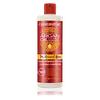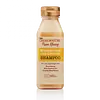What's inside
What's inside
 Benefits
Benefits

 Concerns
Concerns

 Ingredients Side-by-side
Ingredients Side-by-side

Water
Skin ConditioningCetearyl Alcohol
EmollientHydroxypropyl Starch Phosphate
Behentrimonium Chloride
PreservativeSodium Cocoamphopropionate
CleansingDicetyldimonium Chloride
EmulsifyingParfum
MaskingQuaternium-70
Hydroxyethylcellulose
Emulsion StabilisingPanthenol
Skin ConditioningArgania Spinosa Kernel Oil
EmollientPropylene Glycol
HumectantSodium Acetate
BufferingHydrogenated Vegetable Oil
EmollientLactic Acid
BufferingCocodimonium Hydroxypropyl Hydrolyzed Keratin
Skin ConditioningBenzophenone-4
UV AbsorberDisodium EDTA
Isopropyl Alcohol
SolventBenzyl Benzoate
AntimicrobialPhenoxyethanol
PreservativeSodium Benzoate
MaskingWater, Cetearyl Alcohol, Hydroxypropyl Starch Phosphate, Behentrimonium Chloride, Sodium Cocoamphopropionate, Dicetyldimonium Chloride, Parfum, Quaternium-70, Hydroxyethylcellulose, Panthenol, Argania Spinosa Kernel Oil, Propylene Glycol, Sodium Acetate, Hydrogenated Vegetable Oil, Lactic Acid, Cocodimonium Hydroxypropyl Hydrolyzed Keratin, Benzophenone-4, Disodium EDTA, Isopropyl Alcohol, Benzyl Benzoate, Phenoxyethanol, Sodium Benzoate
Water
Skin ConditioningSodium C14-16 Olefin Sulfonate
CleansingCocamidopropyl Betaine
CleansingCocamide Mea
EmulsifyingParfum
MaskingPolyquaternium-10
Glycol Distearate
EmollientGlycol Stearate
EmollientPolysorbate 20
EmulsifyingPanthenol
Skin ConditioningGlycerin
HumectantDimethicone
EmollientHoney
HumectantCocos Nucifera Oil
MaskingButyrospermum Parkii Butter
Skin ConditioningTriethanolamine
BufferingLauryl Alcohol Diphosphonic Acid
Emulsion StabilisingPentylene Glycol
Skin ConditioningLauric Acid
CleansingMica
Cosmetic ColorantBenzophenone-4
UV AbsorberTetrasodium EDTA
Citric Acid
BufferingPhenoxyethanol
PreservativeSodium Benzoate
MaskingMethylparaben
PreservativeEthylparaben
PreservativeCI 15985
Cosmetic ColorantCI 77891
Cosmetic ColorantCI 14700
Cosmetic ColorantCI 42090
Cosmetic ColorantWater, Sodium C14-16 Olefin Sulfonate, Cocamidopropyl Betaine, Cocamide Mea, Parfum, Polyquaternium-10, Glycol Distearate, Glycol Stearate, Polysorbate 20, Panthenol, Glycerin, Dimethicone, Honey, Cocos Nucifera Oil, Butyrospermum Parkii Butter, Triethanolamine, Lauryl Alcohol Diphosphonic Acid, Pentylene Glycol, Lauric Acid, Mica, Benzophenone-4, Tetrasodium EDTA, Citric Acid, Phenoxyethanol, Sodium Benzoate, Methylparaben, Ethylparaben, CI 15985, CI 77891, CI 14700, CI 42090
Ingredients Explained
These ingredients are found in both products.
Ingredients higher up in an ingredient list are typically present in a larger amount.
Benzophenone-4 is a water-soluble chemical sunscreen.
It protects in the UV-B range, but is considered a secondary UV absorber. This means that it needs to be paired with other sunscreen ingredients to provide effective protection.
Typically, it's used in cosmetic products to protect them from deterioration caused by UV rays. This is why you'll find it in a lot of products that aren't sunscreens.
Learn more about Benzophenone-4Panthenol is a common ingredient that helps hydrate and soothe the skin. It is found naturally in our skin and hair.
There are two forms of panthenol: D and L.
D-panthenol is also known as dexpanthenol. Most cosmetics use dexpanthenol or a mixture of D and L-panthenol.
Panthenol is famous due to its ability to go deeper into the skin's layers. Using this ingredient has numerous pros (and no cons):
Like hyaluronic acid, panthenol is a humectant. Humectants are able to bind and hold large amounts of water to keep skin hydrated.
This ingredient works well for wound healing. It works by increasing tissue in the wound and helps close open wounds.
Once oxidized, panthenol converts to pantothenic acid. Panthothenic acid is found in all living cells.
This ingredient is also referred to as pro-vitamin B5.
Learn more about PanthenolParfum is a catch-all term for an ingredient or more that is used to give a scent to products.
Also called "fragrance", this ingredient can be a blend of hundreds of chemicals or plant oils. This means every product with "fragrance" or "parfum" in the ingredients list is a different mixture.
For instance, Habanolide is a proprietary trade name for a specific aroma chemical. When used as a fragrance ingredient in cosmetics, most aroma chemicals fall under the broad labeling category of “FRAGRANCE” or “PARFUM” according to EU and US regulations.
The term 'parfum' or 'fragrance' is not regulated in many countries. In many cases, it is up to the brand to define this term.
For instance, many brands choose to label themselves as "fragrance-free" because they are not using synthetic fragrances. However, their products may still contain ingredients such as essential oils that are considered a fragrance by INCI standards.
One example is Calendula flower extract. Calendula is an essential oil that still imparts a scent or 'fragrance'.
Depending on the blend, the ingredients in the mixture can cause allergies and sensitivities on the skin. Some ingredients that are known EU allergens include linalool and citronellol.
Parfum can also be used to mask or cover an unpleasant scent.
The bottom line is: not all fragrances/parfum/ingredients are created equally. If you are worried about fragrances, we recommend taking a closer look at an ingredient. And of course, we always recommend speaking with a professional.
Learn more about ParfumPhenoxyethanol is a preservative that has germicide, antimicrobial, and aromatic properties. Studies show that phenoxyethanol can prevent microbial growth. By itself, it has a scent that is similar to that of a rose.
It's often used in formulations along with Caprylyl Glycol to preserve the shelf life of products.
Sodium Benzoate is a preservative. It's used in both cosmetic and food products to inhibit the growth of mold and bacteria. It is typically produced synthetically.
Both the US FDA and EU Health Committee have approved the use of sodium benzoate. In the US, levels of 0.1% (of the total product) are allowed.
Sodium benzoate works as a preservative by inhibiting the growth of bacteria inside of cells. It prevents the cell from fermenting a type of sugar using an enzyme called phosphofructokinase.
It is the salt of benzoic acid. Foods containing sodium benzoate include soda, salad dressings, condiments, fruit juices, wines, and snack foods.
Studies for using ascorbic acid and sodium benzoate in cosmetics are lacking, especially in skincare routines with multiple steps.
We always recommend speaking with a professional, such as a dermatologist, if you have any concerns.
Learn more about Sodium BenzoateWater. It's the most common cosmetic ingredient of all. You'll usually see it at the top of ingredient lists, meaning that it makes up the largest part of the product.
So why is it so popular? Water most often acts as a solvent - this means that it helps dissolve other ingredients into the formulation.
You'll also recognize water as that liquid we all need to stay alive. If you see this, drink a glass of water. Stay hydrated!
Learn more about Water